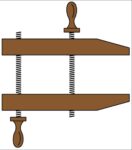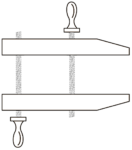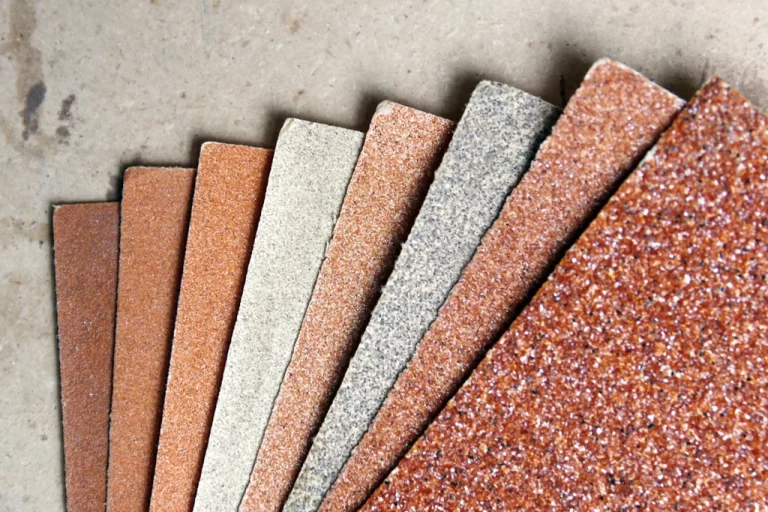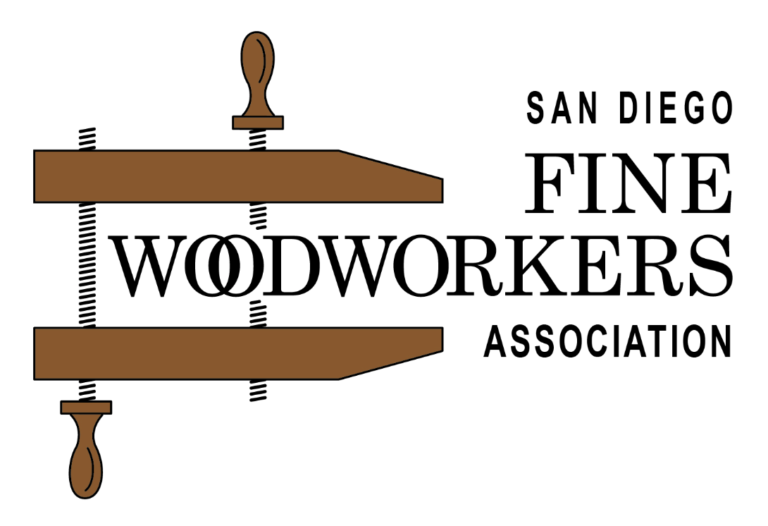Sanding may not be your favorite activity. But where would we be without it? Whatever finish you use, an extremely smooth surface is necessary for a good result. Unless you are both a master hand planer and working on wood blessed with reasonably calm grain you have to resort to sanding to achieve a truly smooth surface.
Norton and 3M dominate the U.S. market for sanding sheets for woodworking. Klingspor, Inc. a U.S. subsidiary of Klingspor AG is also known for high quality abrasives. Their products are not available in retail outlets in California but can be bought online. Buying sandpaper ought to be a simple task, but choosing among several brands, abrasives, backings, closed or open coat, different grading systems for grit size, is confusing. Here is some data from the Internet, Fine Woodworking magazine, and Bob Flexner's outstanding book, Understanding Wood Finishing.
Sandpaper consists of a sheet of backing, to which a layer of very hard particles called grit is applied with an adhesive. Commonly used grit materials for woodworking are; garnet, a natural mineral mined in India and Australia and synthetic compounds aluminum oxide and silicon carbide. Hi-tech ceramic materials (zirconia alumina) used in products for machine sanding are beyond this article's scope. Emery, a natural form of aluminum oxide (corundum) named for Cape Emeri on the Island of Naxos, is suitable for sanding metal.
Garnet produces a smoother finish for a specific size grit than any other abrasive. But this virtue is due to the fact that garnet dulls quickly and cuts slower than other abrasives. Pigmented stains come out lighter and are less likely to blotch or look muddy on a surface sanded with garnet than with other abrasives. It leaves fewer scratches with a random orbit sander and might be best suited for final sanding after using another abrasive. Garnet paper is orange in color.
Aluminum oxide is the only abrasive that fragments under the heat and pressure generated by sanding wood, a characteristic called friability, desirable because it renews its cutting edges constantly, stays sharp longer and cuts faster than other abrasives. It is more expensive than garnet sandpaper. To complicate matters, there are different grades of aluminum oxide. Both Norton and 3M sell premium aluminum oxide papers at higher prices than their regular grades (Norton 3Xtm and ProSandtm and 3M Goldtm). Inexpensive brands use lesser grades which will perform less well. Aluminum oxide paper is usually light tan (gold if stearated). Norton 3X is red or light blue in grades 150 and below.
Silicon carbide is extremely hard. So hard that it will not fragment when used on wood and therefore dulls faster than aluminum oxide. It is used only in water proof sandpaper. If you are a fanatic about sanding, silicon carbide comes in grades up to 6,000, available at automotive stores. It works best wet, and is best suited for sanding finishes rather than bare wood. It is quite expensive. Silicon carbide paper is black (gray if stearated).
To deter clogging sandpaper comes in stearated versions, usually labeled “no-load”. These products contain a “soap” (actually a metal/fatty acid compound) which acts as a non-stick agent and reduces clogging. There is some debate whether a surface sanded with stearated paper needs to be wiped down with alcohol. Norton 3Xtm & 3M Goldtm sandpapers are stearated.
Backing for most sanding sheets is paper, grade A through F according to weight, waterproof in the case of wet/dry sandpaper. Cloth backing is labeled J. Machine sanding products come with paper, PET film or fabric backing. When present, the term “resin” refers to the adhesive. The term “open coat” simply means more space between grit particles. Technical details are rarely present on packaging. The Norton and Klingspor websites have pretty good information. 3M has an extensive, informative catalog which can be found in their woodworking catalog.
http://multimedia.3m.com/mws/media/148465O/3mtm-industrial-products-for-woodworking-catalog.pdf
Volumes are written on how to sand; interval between grits, how high a grit for final sanding, etc. Some salient points: Bob Flexner says that, although grits higher than 180 produce smoother, more glossy surfaces, application of a film finish (e.g. varnish) makes a surface sanded to 180 indistinguishable from a surface sanded to higher grits. I personally like to go to 220 or even 320 and it makes you feel virtuous.
Whatever technique you prefer, starting with too fine a grade or skipping grades wastes time because the finer grade will reveal defects that require going back to a lower grade. Before applying a finish, take care to thoroughly remove lingering dust and meticulously inspect the surface in reflected light for glue residue, dings, scratches and tool marks; the finish also invariably reveals these defects and forces you to start all over again. For a water born finish or shellac, wipe down with a moist rag and sand once more to remove whiskers before finishing.
The two common rating systems for grit size are: CAMI (Coated Abrasives Manufacturing Institute), once the U.S. standard, and FEPA (Federation of European Producers Association), the European standard. FEPA is increasingly used by U.S. brands. 3M grit numbers are marked P if they are FEPA grades. Not all brands do this. Norton has switched to the FEPA system for all its products. If in doubt you have to call the company. Actual particle diameter is what matters. In the table below note that grit sizes in the CAMI system are smaller than in the corresponding FEPA grade; a relatively small difference below 240 grit.
Rating Av. Particle Diam. Microns
P80 201
80 190
P100 162
100 140
P120 125
120 115
P150 100
150 92
P180 & 180 82
P220 & 220 68
P240 58.5
240 53
P280 52.2
P320 46.2
P360 40.5
320 36
P400 35
360 28
400 23
My favorite brand is Norton 3Xtm, but 3M Goldtm is probably equal. Norton has recently introduced a super premium product called Pro Sandtm which boasts heavier backing and heat treated abrasive. I have not tried it. Being thrifty, I tend to use sandpaper until it wears out and save scraps. Those who do woodworking for a living tell us that the time spent using cheap or worn out sandpaper costs more than the expense of fresh sandpaper.
Of course there are alternatives to hand sanding, card scrapers and especially random orbit sanders. There is not enough space to discuss these options but an excellent article in FWW #222 named the Klingspor V900 line of discs best overall and best value based on measured wood removed per penny of cost in Nov. 2011.
By Dick Ugoretz (originally published on June 2015)
Editor's Note: Light edits have been made to remove broken web links.






